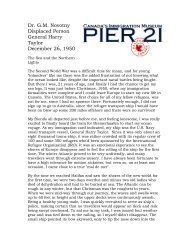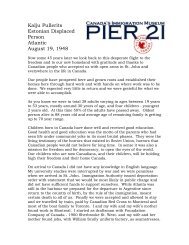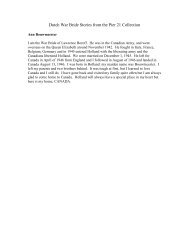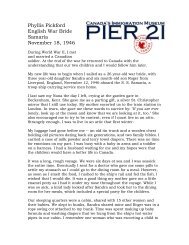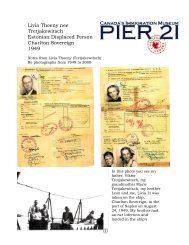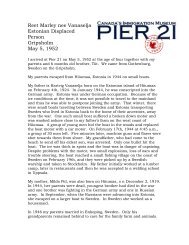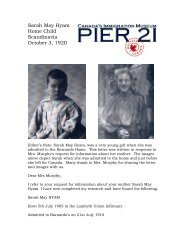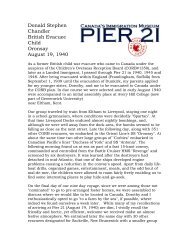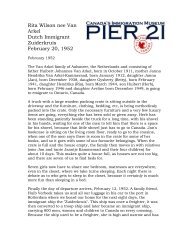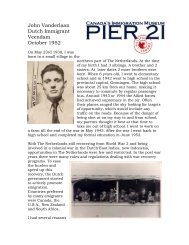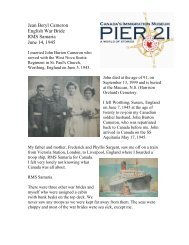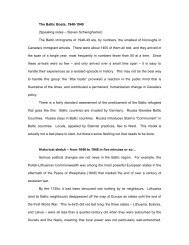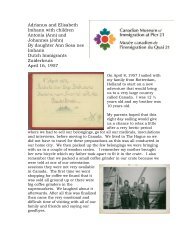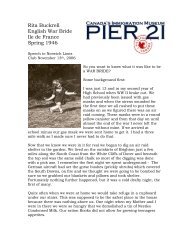Dutch and German Immigrants The Prins Family - Pier 21
Dutch and German Immigrants The Prins Family - Pier 21
Dutch and German Immigrants The Prins Family - Pier 21
You also want an ePaper? Increase the reach of your titles
YUMPU automatically turns print PDFs into web optimized ePapers that Google loves.
came from Kenora in Saskatchewan <strong>and</strong> Mike <strong>and</strong> I worked the sameshift in the plant. Mike <strong>and</strong> Ann have passed away but we still havecontact with their daughter Barbara who has a family of her own <strong>and</strong>still lives in Kitimat. A while later I met Henry <strong>and</strong> Bethel Papenbrock,originally from Osnabruck <strong>German</strong>y. Henry <strong>and</strong> I also worked together<strong>and</strong> after work we washed each other’s back. Henry was a carpenter bytrade <strong>and</strong> he later helped me build my first house on the Graham road(this was after I had married). One of his sons, Andrew, lives not too farfrom us <strong>and</strong> keeps us posted about the rest of the Papenbrocks.<strong>The</strong>n there was 'Bies <strong>and</strong> his wife Jopie Bisenberger, a <strong>Dutch</strong> couplefrom Z<strong>and</strong>voort. Small world as he was a cousin of Klaar’s wife Leni.Jopie <strong>and</strong> Bies moved to Smithers BC a couple of years later. At thattime I lived in Terrace <strong>and</strong> once in a while we drove to Smithers to visitthem; more about them later in the journal.<strong>The</strong> road between Terrace <strong>and</strong> Smithers was built during the war by thearmy. Running mostly along the Skeena River there are several rockbluffs, which had to be blasted to facilitate the road building. <strong>The</strong> armyblasted just enough for a narrow two car passage with not much room tospare. Beside the rock bluffs the rest of the road was gravel, mostly'washboard' gravel after a rainy day. After we left Terrace for Alberta theywidened <strong>and</strong> straightened the road to a modern highway; some of thepassages through the rock costing more than a million dollars a mile.Once lines 3, 4 <strong>and</strong> 5 were on stream, we were able to make a lot ofovertime. For three weeks in a row I worked my regular 8 hour shift <strong>and</strong>right after that shift 8 hours overtime, then 8 hours of sleep <strong>and</strong> myregular shift followed by 16 hours off <strong>and</strong> repeat this work pattern. <strong>The</strong>extra money earned over these three weeks paid for a big part of myholiday in Mexico.I first flew to Vancouver <strong>and</strong> renewed acquaintances in the lowermainl<strong>and</strong>. I stayed with the family Berquist in New Westminster, <strong>and</strong> inthe mean time, obtained my visa to enter Mexico. I boarded theGreyhound bus for San Francisco <strong>and</strong> Los Angeles to stay a day in eachcity to visit the tourist spots <strong>and</strong> then via Arizona <strong>and</strong> New Mexico to ElPaso in Texas. When you travel through this part of the United Statesyou do not exactly see the 'American dream', at least that how it seemedto me in 1957. In El Paso I switched busses <strong>and</strong> it was another 36 hoursto Mexico City.To travel through that country was quite an experience. <strong>The</strong> only greenareas you see are the irrigated areas. Whenever the bus encountered adetour on the road you just travel on through the fields beside it <strong>and</strong>when the road was alright again up we went <strong>and</strong> on the road again. On



